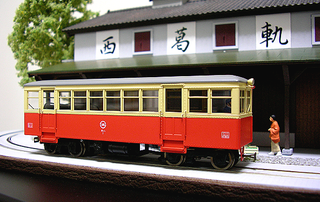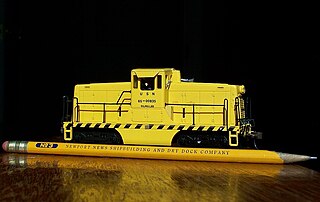
Railway modelling or model railroading is a hobby in which rail transport systems are modelled at a reduced scale.

Lionel, LLC is an American designer and importer of toy trains and model railroads that is headquartered in Concord, North Carolina. Its roots lie in the 1969 purchase of the Lionel product line from the Lionel Corporation by cereal conglomerate General Mills and subsequent purchase in 1986 by businessman Richard P. Kughn forming Lionel Trains, Inc. in 1986. The Martin Davis Investment Group (Wellspring) bought Lionel Trains, Inc. in 1995 and renamed it Lionel, LLC.

O scale is a scale commonly used for toy trains and rail transport modelling. Introduced by German toy manufacturer Märklin around 1900, by the 1930s three-rail alternating current O gauge was the most common model railroad scale in the United States and remained so until the early 1960s. In Europe, its popularity declined before World War II due to the introduction of smaller scales.

HO or H0 is a rail transport modelling scale using a 1:87 scale. It is the most popular scale of model railway in the world. The rails are spaced 16.5 millimetres (0.650 in) apart for modelling 1,435 mm standard gauge tracks and trains in HO.

The New York Central Hudson was a popular 4-6-4 "Hudson" type steam locomotive built by the American Locomotive Company (ALCO) and the Lima Locomotive Works in three series from 1927 to 1938 for the New York Central Railroad. Named after the Hudson River, the 4-6-4 wheel arrangement came to be known as the "Hudson" type in the United States, as these locomotives were the first examples built and used in North America. Built for high-speed passenger train work, the Hudson locomotives were famously known for hauling the New York Central's crack passenger trains, such as the 20th Century Limited and the Empire State Express. With the onset of diesel locomotives by the mid-20th Century, all Hudson locomotives were retired and subsequently scrapped by 1957, with none preserved today except for a converted tender from J-1d 5313, which is preserved at the Steamtown National Historic Site in Scranton, Pennsylvania.

American Flyer is a brand of toy train and model railroad manufactured in the United States.
Standard Gauge, also known as wide gauge, was an early model railway and toy train rail gauge, introduced in the United States in 1906 by Lionel Corporation. As it was a toy standard, rather than a scale modeling standard, the actual scale of Standard Gauge locomotives and rolling stock varied. It ran on three-rail track whose running rails were 2+1⁄8 in apart.
The Ives Manufacturing Company, an American toy manufacturer from 1868 to 1932, was the largest manufacturer of toy trains in the United States from 1910 until 1924, when Lionel Corporation overtook it in sales.

A toy train is a toy that represents a train. It is distinguished from a model train by an emphasis on low cost and durability, rather than scale modeling. A toy train can be as simple as a toy that can run on a track, or it might be operated by electricity, clockwork or live steam. It is typically constructed from wood, plastic or metal. Many of today's steam trains might be considered as real ones as well, providing they are not strictly scale or not enough detailed ones in favor of a robustness appropriate for children or an inexpensive production.
K-Line Electric Trains is a brand name of O gauge and S gauge model railway locomotives, rolling stock, and buildings. Formerly the brand name under which Chapel Hill, North Carolina-based MDK Inc. sold its products, K-Line was then acquired by Sanda Kan, a Chinese toy manufacturer that formerly acted as K-Line's subcontractor. Sanda Kan had licensed the use of the K-Line brand and intellectual property to Lionel. More recently, the Lionel license expired, and Sanda Kan sold the dies to several other companies, with some going to each of Atlas, Bachmann, and RMT.
S scale is a model railroad scale modeled at 1:64 scale, S scale track gauge is 22,48 (22,5) mm, 0.885 in. S gauge trains are manufactured in both DC and AC powered varieties. S gauge is not to be confused with toy train standard gauge, a large-scale standard for toy trains in the early part of the 20th century.

The Hafner Manufacturing Company was a maker of tinplate clockwork-powered O gauge toy trains, based in Chicago, Illinois, from 1914 to 1951. It was formed when its founder, William Frederick Hafner, a co-founder of American Flyer, left the company in favor of creating his own company.
Hornby Railways is a British model railways manufacturing company. Its roots date back to 1901 in Liverpool, when founder Frank Hornby received a patent for his Meccano construction toy. The first clockwork train was produced in 1920. In 1938, Hornby launched its first 00 gauge train. In 1964, Hornby and Meccano were bought by their competitor, Tri-ang, and sold when Tri-ang went into receivership. Hornby Railways became independent again in the 1980s, and became listed on the London Stock Exchange, but due to financial troubles reported in June 2017, became majority owned by British turnaround specialist Phoenix Asset Management.

The use of a third rail in rail transport modelling is a technique that was once applied, in order to facilitate easier wiring.

Bachmann Industries is a Bermuda-registered, Chinese-owned company, globally headquartered in Hong Kong; specialising in model railroading.

Bing or Gebrüder Bing was a German toy company founded in 1863 in Nuremberg, Germany by two brothers, Ignaz Bing and Adolf Bing, originally producing metal kitchen utensils, but best remembered for its extensive lines of model trains and live steam engines.
Williams Electric Trains was an American toy train and model railroad manufacturer, based in Columbia, Maryland. Williams was sold to Kader via their subsidiary Bachmann Industries in October 2007, and is now identified as "Williams by Bachmann."

Lionel Corporation was an American toy manufacturer and holding company of retailers that had been in business for over 120 years. It was founded as an electrical novelties company. Lionel specialized in various products throughout its existence. Toy trains and model railroads were its main claim to fame. Lionel trains have been produced since 1900, and their trains drew admiration from model railroaders around the world for the solidity of their construction and the authenticity of their detail. During its peak years in the 1950s, the company sold $25 million worth of trains per year. In 2006, Lionel's electric train became the first electric toy inducted into the National Toy Hall of Fame. In 1969, they sold their model train lines to General Mills, but continued to operate until 1993 as a holding company for their toy stores. Its model trains are still in production as a separate company.

The San Diego Model Railroad Museum is a model railroad exhibit in San Diego, California. At 27,000 sq. ft., it is the largest such indoor exhibit in North America, and one of the largest in the world. The museum is located on the lower level of the Casa de Balboa Building on the Prado in Balboa Park.

The Train Collectors Association (TCA) is an international non-profit organization of people who operate and collect toy trains, toy train accessories, toy train books, toy train paper, and anything else rail transport related. TCA was founded in October 1954 in Yardley, Pennsylvania and is currently headquartered in Strasburg, Pennsylvania. The National Toy Train Museum affiliated with TCA is included in the "List of museums in Pennsylvania".













